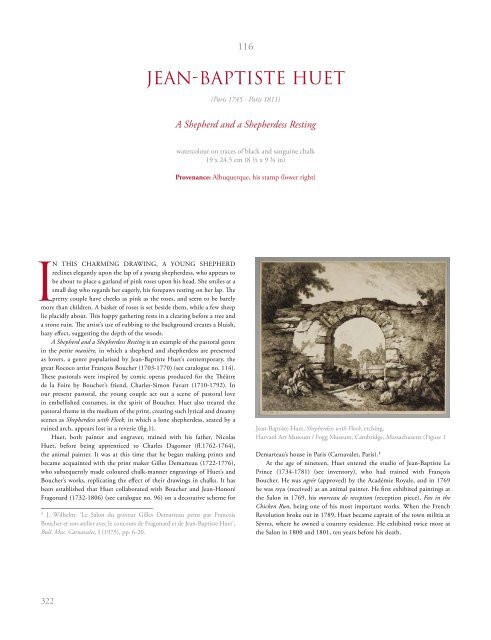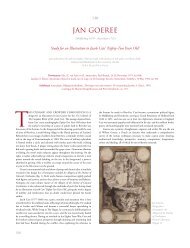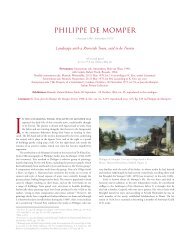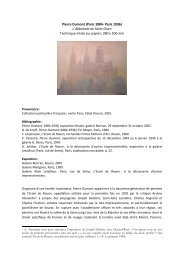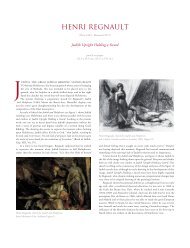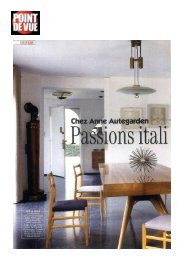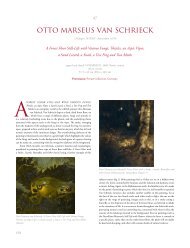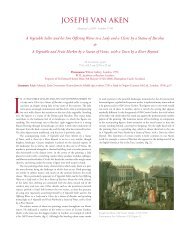Jean Baptiste Huet - A Shepherd and Shepherdess Resting
Jean Baptiste Huet - A Shepherd and Shepherdess Resting
Jean Baptiste Huet - A Shepherd and Shepherdess Resting
You also want an ePaper? Increase the reach of your titles
YUMPU automatically turns print PDFs into web optimized ePapers that Google loves.
In this chArming drAwing, A young shepherd<br />
reclines elegantly upon the lap of a young shepherdess, who appears to<br />
be about to place a garl<strong>and</strong> of pink roses upon his head. she smiles at a<br />
small dog who regards her eagerly, his forepaws resting on her lap. The<br />
pretty couple have cheeks as pink as the roses, <strong>and</strong> seem to be barely<br />
more than children. A basket of roses is set beside them, while a few sheep<br />
lie placidly about. This happy gathering rests in a clearing before a tree <strong>and</strong><br />
a stone ruin. The artist’s use of rubbing to the background creates a bluish,<br />
hazy effect, suggesting the depth of the woods.<br />
A <strong>Shepherd</strong> <strong>and</strong> a <strong>Shepherd</strong>ess <strong>Resting</strong> is an example of the pastoral genre<br />
in the petite manière, in which a shepherd <strong>and</strong> shepherdess are presented<br />
as lovers, a genre popularised by <strong>Jean</strong>-<strong>Baptiste</strong> huet’s contemporary, the<br />
great rococo artist François Boucher (1703-1770) (see catalogue no. 114).<br />
These pastorals were inspired by comic operas produced for the Théâtre<br />
de la Foire by Boucher’s friend, charles-simon Favart (1710-1792). in<br />
our present pastoral, the young couple act out a scene of pastoral love<br />
in embellished costumes, in the spirit of Boucher. huet also treated the<br />
pastoral theme in the medium of the print, creating such lyrical <strong>and</strong> dreamy<br />
scenes as <strong>Shepherd</strong>ess with Flock, in which a lone shepherdess, seated by a<br />
ruined arch, appears lost in a reverie (fig.1).<br />
huet, both painter <strong>and</strong> engraver, trained with his father, nicolas<br />
huet, before being apprenticed to charles dagomer (fl.1762-1764),<br />
the animal painter. it was at this time that he began making prints <strong>and</strong><br />
became acquainted with the print maker gilles demarteau (1722-1776),<br />
who subsequently made coloured chalk-manner engravings of huet’s <strong>and</strong><br />
Boucher’s works, replicating the effect of their drawings in chalks. it has<br />
been established that huet collaborated with Boucher <strong>and</strong> <strong>Jean</strong>-honoré<br />
Fragonard (1732-1806) (see catalogue no. 96) on a decorative scheme for<br />
¹ J. wilhelm: ‘Le salon du graveur gilles demarteau peint par Francois<br />
Boucher et son atelier avec le concours de Fragonard et de <strong>Jean</strong>-<strong>Baptiste</strong> huet’,<br />
Bull. Mus. Carnavalet, i (1975), pp. 6-20.<br />
322<br />
116<br />
JEAN-BAPTISTE HUET<br />
(Paris 1745 - Paris 1811)<br />
A <strong>Shepherd</strong> <strong>and</strong> a <strong>Shepherd</strong>ess <strong>Resting</strong><br />
watercolour on traces of black <strong>and</strong> sanguine chalk<br />
19 x 24.5 cm (8 ½ x 9 ¾ in)<br />
Provenance: Albuquerque, his stamp (lower right)<br />
<strong>Jean</strong>-<strong>Baptiste</strong> huet, <strong>Shepherd</strong>ess with Flock, etching,<br />
harvard Art museum / Fogg museum, cambridge, massachusetts (Figure 1<br />
demarteau’s house in paris (carnavalet, paris).¹<br />
At the age of nineteen, huet entered the studio of <strong>Jean</strong>-<strong>Baptiste</strong> Le<br />
prince (1734-1781) (see inventory), who had trained with François<br />
Boucher. he was agrée (approved) by the Académie royale, <strong>and</strong> in 1769<br />
he was reçu (received) as an animal painter. he first exhibited paintings at<br />
the salon in 1769, his morceau de reception (reception piece), Fox in the<br />
Chicken Run, being one of his most important works. when the French<br />
revolution broke out in 1789, huet became captain of the town militia at<br />
sèvres, where he owned a country residence. he exhibited twice more at<br />
the salon in 1800 <strong>and</strong> 1801, ten years before his death.
(Actual size)


